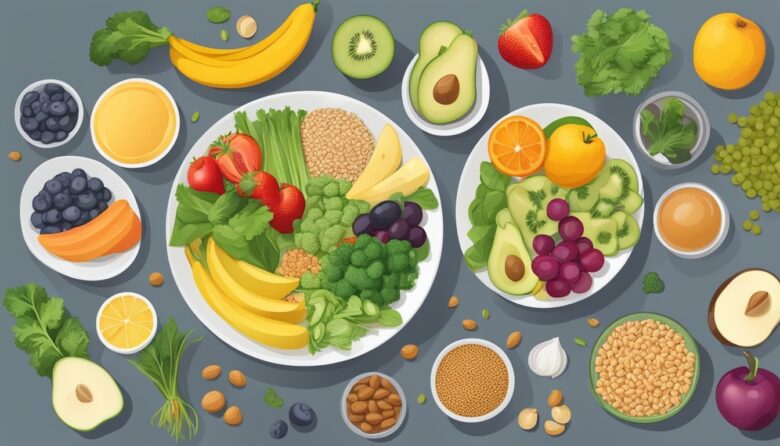Flexitarianism, a term blending flexibility with vegetarianism, has gained momentum as a dietary approach offering a middle ground between plant-based and meat-based eating habits. This article explores the concept of Flexitarianism, delving into its definition, significance in maintaining a balanced diet, and its rising popularity among health-conscious individuals.
Understanding Flexitarianism
Origins of Flexitarianism
The term “Flexitarianism” was coined in the early 2000s by dietitian Dawn Jackson Blatner, reflecting a shift towards incorporating more plant-based foods while occasionally consuming meat.
Philosophy behind Flexitarianism
Flexitarianism advocates for a predominantly plant-based diet while allowing for occasional consumption of meat or animal products, promoting sustainability, health, and ethical eating practices.
Benefits of Flexitarianism
Flexitarian diets have been linked to numerous health benefits, including reduced risk of chronic diseases such as heart disease and type 2 diabetes, improved weight management, and enhanced digestive health.
Health Benefits of Flexitarianism
Reduced Risk of Chronic Diseases
Studies have shown that diets rich in fruits, vegetables, whole grains, and legumes, typical of a flexitarian approach, can lower the risk of chronic diseases and promote overall well-being.
Weight Management
The emphasis on plant-based foods in Flexitarianism can aid in weight management by providing nutrient-dense, low-calorie options that promote satiety and support healthy weight loss.
Improved Digestive Health
Fiber-rich plant foods, integral to Flexitarianism, contribute to better digestive health by promoting regularity, supporting gut microbiome diversity, and reducing the risk of gastrointestinal disorders.
Environmental Impact of Flexitarianism
Reducing Carbon Footprint
By prioritizing plant-based foods over meat, Flexitarianism helps reduce greenhouse gas emissions associated with livestock production, contributing to efforts to mitigate climate change.
Water Conservation
Plant-based diets require significantly less water for production compared to meat-based diets, making Flexitarianism a more sustainable choice in terms of water usage.
Preservation of Biodiversity
Reduced demand for animal products through Flexitarianism can help alleviate pressure on ecosystems and wildlife habitats, promoting biodiversity conservation.
Economic Considerations
Cost-effectiveness of Plant-based Diets
Flexitarianism can be more cost-effective than traditional meat-heavy diets, as plant-based proteins such as beans, lentils, and tofu are often more affordable than animal products.
Impact on Agricultural Industry
The shift towards plant-based eating encouraged by Flexitarianism may impact the agricultural industry, promoting the cultivation of diverse crops and sustainable farming practices.
Accessibility of Plant-based Foods
Plant-based foods are widely available and accessible, making Flexitarianism an inclusive dietary approach suitable for individuals from diverse socioeconomic backgrounds.
How to Transition to a Flexitarian Diet
Gradual Reduction of Meat Consumption
Transitioning to a Flexitarian diet involves gradually reducing meat consumption while increasing the intake of plant-based foods, allowing for a smooth and sustainable dietary transition.
Incorporating More Plant-based Meals
Flexitarians focus on incorporating more fruits, vegetables, whole grains, legumes, nuts, and seeds into their meals, experimenting with new flavors and recipes for a varied diet.
Finding Alternatives to Meat
Flexitarians explore meat alternatives such as tofu, tempeh, seitan, and plant-based meat substitutes to satisfy cravings and diversify their protein sources.
Tips for Balanced Flexitarian Meals
Planning Meals Ahead
Meal planning is essential for maintaining a balanced Flexitarian diet, ensuring that meals are nutritionally diverse, satisfying, and aligned with personal dietary preferences.
Embracing Variety
Flexitarians embrace culinary diversity by incorporating a wide range of plant-based foods, herbs, spices, and ethnic cuisines into their meals for added flavor and nutrition.
Using Spices and Herbs
Spices and herbs not only enhance the taste of Flexitarian dishes but also offer numerous health benefits, including anti-inflammatory and antioxidant properties.
Flexitarianism for Families
Involving Children in Meal Planning
Engaging children in meal planning and preparation can foster a positive attitude towards plant-based foods and empower them to make healthy food choices.
Making Plant-based Foods Appealing to Kids
Creative presentation, colorful dishes, and involvement in cooking can make plant-based foods more appealing to children, encouraging them to explore new flavors and textures.
Finding Family-friendly Recipes
Flexitarian families can enjoy a variety of family-friendly recipes that incorporate plant-based ingredients in familiar dishes, making mealtime enjoyable for everyone.
Navigating Social Situations
Communicating Dietary Choices to Others
Open communication about dietary choices is key to navigating social situations as a Flexitarian, helping friends and family understand and accommodate individual preferences.
Bringing Flexitarian Dishes to Gatherings
Bringing Flexitarian dishes to social gatherings ensures that there are options available that align with personal dietary choices, fostering inclusivity and diversity in shared meals.
Exploring Restaurants
Flexitarians can explore restaurants that offer diverse menus with plant-based options, supporting establishments that prioritize sustainability and cater to diverse dietary preferences.
Addressing Common Concerns
Meeting Protein Needs
Flexitarians can easily meet their protein needs by incorporating a variety of plant-based protein sources such as legumes, tofu, tempeh, nuts, and seeds into their meals.
Ensuring Nutritional Adequacy
A well-planned Flexitarian diet can provide all essential nutrients, including protein, iron, calcium, and vitamin B12, through a variety of plant-based foods and supplements if needed.
Dealing with Social Pressure
Flexitarians may face social pressure or skepticism regarding their dietary choices, but confidently asserting personal beliefs and educating others about Flexitarianism can help alleviate concerns.
Flexitarian Recipes and Meal Ideas
Breakfast Ideas
Avocado Toast: Whole-grain toast topped with mashed avocado, cherry tomatoes, and a sprinkle of hemp seeds.
Smoothie Bowl: Blend spinach, banana, frozen berries, and almond milk, then top with granola and sliced fruit.
Lunch Options
Quinoa Salad: Mix cooked quinoa with diced vegetables, chickpeas, and a lemon-tahini dressing.
Veggie Wrap: Fill a whole-grain wrap with hummus, shredded carrots, cucumber, bell peppers, and greens.
Dinner Recipes
Vegetable Stir-fry: Sauté mixed vegetables with tofu or tempeh in a ginger-soy sauce, served over brown rice.
Sweet Potato Black Bean Chili: Simmer sweet potatoes, black beans, tomatoes, and spices for a hearty chili.
Snack Suggestions
Trail Mix: Combine nuts, seeds, dried fruit, and dark chocolate chips for a satisfying snack.
Roasted Chickpeas: Season chickpeas with olive oil and spices, then bake until crispy for a crunchy snack.
Sustainability Practices
Embracing Seasonal and Local Produce
Choosing seasonal and locally grown produce supports sustainable agriculture, reduces food miles, and promotes environmental stewardship.
Reducing Food Waste
Flexitarians minimize food waste by planning meals, utilizing leftovers creatively, and composting food scraps, contributing to a more sustainable food system.
Supporting Ethical Food Practices
Opting for ethically sourced, organic, and fair-trade products aligns with the values of Flexitarianism, promoting social responsibility and humane treatment of animals.
Flexitarianism and Cultural Perspectives
Flexitarianism in Different Cultures
Flexitarian dietary patterns are evident across various cultures, reflecting historical, environmental, and cultural influences on food choices and eating habits.
Traditional Plant-based Meals
Many cultures have traditional plant-based dishes that form the foundation of Flexitarian diets, incorporating locally available ingredients and culinary techniques.
Cultural Attitudes Towards Meat
Attitudes towards meat consumption vary across cultures, with some societies placing greater emphasis on plant-based foods for health, environmental, or ethical reasons.
Flexitarianism: A Lifelong Journey
Embracing Flexibility
Flexitarianism emphasizes flexibility and balance, allowing individuals to adapt their dietary choices based on personal preferences, lifestyle factors, and evolving nutritional needs.
Continuing Education on Nutrition
Staying informed about nutrition and dietary guidelines empowers Flexitarians to make informed food choices that promote health, sustainability, and overall well-being.
Adapting to Changing Dietary Needs
Flexitarianism accommodates changing dietary needs throughout life stages, offering flexibility to adjust food choices to support optimal health and longevity.
Conclusion
In conclusion, Flexitarianism offers a sustainable and balanced approach to eating that promotes health, environmental stewardship, and culinary diversity. By embracing a predominantly plant-based diet while allowing for occasional consumption of meat, Flexitarians can enjoy the benefits of both worlds, fostering personal well-being and contributing to a more sustainable food system. As we strive for a healthier and more harmonious relationship with food and the planet, Flexitarianism emerges as a promising dietary philosophy for the future.
FAQs about Flexitarianism
What is Flexitarianism?
Is Flexitarianism suitable for vegetarians or vegans?
Can Flexitarianism help with weight loss?
How to handle cravings on a flexitarian diet?
What are some common misconceptions about Flexitarianism?
Is Flexitarianism environmentally sustainable?



